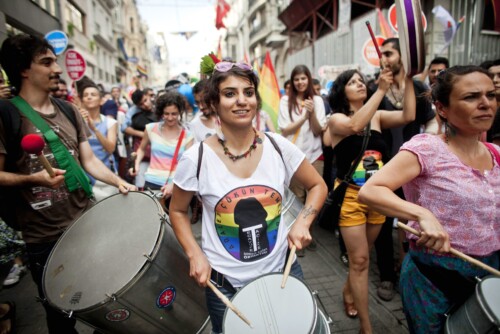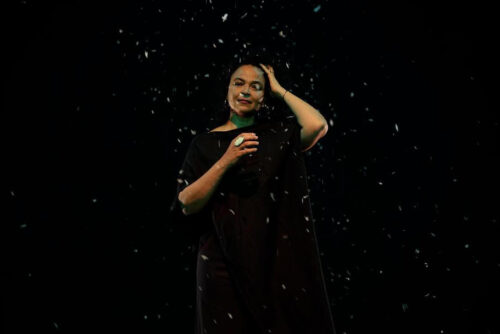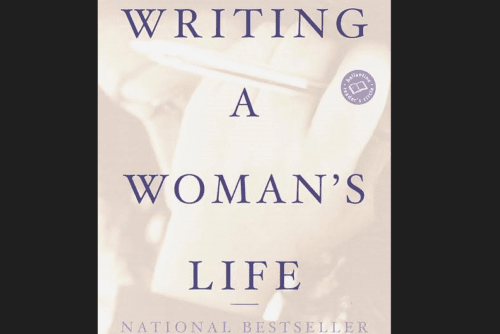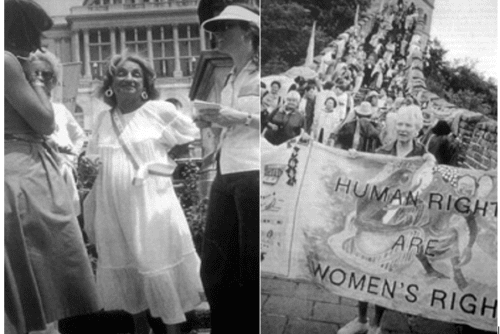II. Queering Human Rights
In transnational advocacy, the language of human rights has become something of a hegemonic framework for advancing a range of claims related to personal freedom, recognition by state actors, access to goods and services, equal treatment, and human dignity. This was not always the case. As Samuel Moyn has persuasively argued, the centrality of human rights in claims-making is a more recent phenomenon than the UN’s adoption of the Universal Declaration of Human Rights (UDHR) in 1948, or even the International Human Rights Year in 1968.1 The concept of human rights had some purchase at the time of the UDHR—and, of course, antecedent theories of rights, citizenship, and dignity did as well—but it was not until the 1970s that human rights began to be widely adopted as a discursive and political tool to assert individual claims against the state.2
Globally, many LGBT groups seized upon human rights framings very early in their lifespans, in part because other characterizations of their claims—for example, as matters of tradition, civil rights, or liberation in their domestic contexts—were unpromising or expressly foreclosed. Such a strategy is apparent in the appellations adopted by a number of domestic NGOs worldwide that work extensively on LGBT issues, for example, the Human Rights Campaign (HRC) in the United States or the Centre for Popular Education and Human Rights (CEPEHRG) in Ghana.3 The term “human rights” euphemistically avoided any mention of “homosexual,” “gay,” or “lesbian” mobilization in contexts where visible identification and assembly under these banners was likely to invite unwanted backlash. But more powerfully, it also evoked an official sounding legal framework that gained considerable moral legitimacy and power from the anti-apartheid movement in South Africa and other global struggles of the 1970s and 1980s. For largely volunteer organizations seeking the freedom to organize, the veneer of human rights could at times facilitate registration, credibility, networking, and influence, both domestically and transnationally.
As often as LGBT activists have adopted the rhetoric of human rights, however, archival and ethnographic work illustrate that they have not limited their advocacy to legalistic or technical interpretations of the rights enshrined in global agreements. The adoption of a more expansive understanding of human rights in the sexual rights context is understandable. The texts of the UDHR, the International Covenant on Civil and Political Rights (ICCPR), and the International Covenant on Economic, Social and Cultural Rights (ICESCR), among other agreements, do not expressly prohibit discrimination on the basis of sexual orientation and gender identity and expression (SOGI). Activists have had to work over time to secure clarification from treaty monitoring bodies, working groups, and Special Rapporteurs affirming that discrimination on the basis of SOGI is impermissible under international law. To establish that precedent, LGBT activists have insisted that LGBT people are entitled to enjoy the full panoply of established human rights by virtue of their humanity, invoking the universality of human rights rather than legalistic or technical understandings of particular guarantees.
To assert demands within a human rights framework, LGBT activists have simultaneously engaged in processes that might be termed translation, specification, and expansion. In translation, activists recast the needs of LGBT populations in the discourse of legally actionable human rights, a language that policymakers at the national and supranational levels ideally will take seriously. In specification, activists seek to more overtly include LGBT populations in human rights guarantees. Where a direct correlation to existing rights is difficult or uncompelling, activists are more likely to demand transformative changes to the human rights framework itself. In expansion, activists insist that issues that may not be cognizable within a traditional human rights framework are, in fact, concerns that the framework should grow to recognize and accommodate. All three processes have allowed LGBT activists to situate their claims more comfortably in the human rights framework over time.
Demands for LGBT rights often blend these ideal types, but it is useful to consider translation, specification, and expansion in turn to understand their possibilities and limitations as strategies for codifying LGBT rights as human rights. One example that is closely akin to translation is the characterization of claims to sexual autonomy in the language of a right to privacy. Nowadays, it is widely understood that the right to privacy protects at least some sexual activity between consenting adults—at least insofar as the activity takes place in a sphere that the state recognizes as “private.”4 But this understanding of the right to privacy was not always self-evident, and is instead the product of deliberate contestation over time by sexual rights advocates. Around the globe, prohibitions on contraception, abortion, adultery, and same-sex activity have often been enshrined in domestic criminal law, and regarded as matters to be addressed by police and prosecuted by the state. In the United States, advocates challenging these laws spurred the Supreme Court to recognize an implicit “right to privacy” in the Constitution that protected access to contraception, abortion, and eventually, same-sex activity between consenting adults.5 In transnational forums, too, the right to privacy has been contested and dynamic. The European Court of Human Rights has declined to find that the right to privacy guarantees access to abortion,6 for example, but both regional and international human rights bodies have readily interpreted the right to privacy to protect same-sex activity between two consenting adults in private.7 Although the right to privacy remains a contested framing with visible limitations, the notion of a right to privacy has been a powerful tool for advocates seeking to move sexual autonomy and intimacy from the realm of criminality to the realm of rights, and sexual rights activists have played a key role in translating claims to bring that about.8
Translation has also animated efforts to ensure that LGBT people are protected from discrimination under the ICCPR, ICESCR, and other human rights treaties. At times, activists have argued that, although “SOGI” does not expressly appear in human rights treaties, the existing textual provisions of these treaties nevertheless prohibit discrimination on the basis of SOGI. Arguments along these lines have been fruitful. In Toonen v. Australia, for example, the UN Human Rights Committee determined that the term “sex” in the ICCPR should be understood to encompass “sexual orientation.”9 In the European system, a similar interpretation of the term “sex” has served to cover gender identity and expression.10 Open-ended prohibitions of discrimination have also been interpreted to include SOGI; in General Comment 20, for example, the UN Committee on Economic, Social and Cultural Rights concluded that the term “other status” in the ICESCR should be understood to include both sexual orientation and gender identity.11
As recognition of LGBT human rights grows, activists have also engaged in specification, and have sought to include SOGI in a more explicit way as prohibited grounds for discrimination. Instead of reinterpreting existing law, these efforts seek to craft language and guarantees that are expressly cognizant of LGBT people.12 In both domestic and transnational law, prohibitions against discrimination are typically couched in terms of categories that, for historical, philosophical, and political reasons, are declared to be presumptively inappropriate bases for adverse treatment. By seeking prohibitions against discrimination on the basis of SOGI, activists press for a more affirmative and explicit recognition of LGBT lives in the textual fabric of international human rights guarantees.13 Such efforts name and codify those categories as dimensions of the self that all persons—including heterosexual and cisgender persons—innately possess by virtue of their humanity.14
Where a direct analogue with existing rights is difficult or uncompelling, activists are more likely to eschew translation or specification and demand transformative changes to the human rights framework itself. In doing so, they expand the conventional limits of human rights to ensure they are capacious enough to address the violations that LGBT people disproportionately face. Elsewhere, I have written about a number of claims that have at least some expansionist elements.15 A traditional understanding of “rights”—as entitlements an individual can assert against a state—would not obviously equip activists to tackle issues like marginalization by faith communities, family members, and other non-state actors; disparate rates of mental and physical health problems; and worryingly high incidences of crimes like blackmail, assault, or rape. Like other forms of sexual rights advocacy, especially feminist and women’s rights advocacy, campaigns against these kinds of violations not only borrow from the human rights framework, but demand that it take stock of the felt needs of marginalized populations and hold a broader set of actors accountable for a wider range of violations and indignities.
In these processes of translation, specification, and expansion, LGBT human rights activists have adopted stances that generalist human rights NGOs, governments, and intergovernmental bodies at times have been reluctant to embrace. Established actors may fear that these strategic moves will dilute the defined corpus of human rights or weaken its normative power by making it a target for ridicule or criticism. For those who primarily seek entry into the system, however, such tactics can be fruitful as a means of both legitimating and satisfying a movement’s objectives.
Yet as more and more actors in the human rights arena embrace LGBT rights as human rights, LGBT activists are likely to face unique challenges stemming from the institutional recognition of their claims. In particular, there is a risk that activists may be hampered in their ability to work outside the realm of conventional understandings and will lose the flexibility they have previously enjoyed by virtue of their entry into the halls of power. Although mainstream critiques of human rights are instructive, the unique considerations of LGBT advocacy give rise to some specific issues that merit exploration as the landscape changes.
- See Samuel Moyn, The Last Utopia: Human Rights in History (Cambridge, MA: Belknap Press, 2010), 1-10.
[↩] - Moyn, The Last Utopia, 1-10. [↩]
- In the United States, Chicago’s Society for Human Rights, founded in 1924, was an early example of a homophile group adopting a human rights framing. Such framings gained additional traction with the passage of the UDHR in 1948. One homophile coalition spanning Denmark, Norway, and Sweden called itself the Forbundet af 1948, or “League of 1948,” referentially invoking the guarantees of the UDHR. See Leila J. Rupp, “The European Origins of Transnational Organizing: The International Committee for Sexual Equality,” in LGBT Activism and the Making of Europe: A Rainbow Europe?, ed. Phillip M. Ayoub & David Paternotte (Basingstoke: Palgrave Macmillan, 2014), 32, 40. [↩]
- It is important to note, however, that the right to privacy also has been narrowly interpreted to exclude sex that is deemed insufficiently “private” and sex that is construed to implicate concerns about public morals or public health. See, e.g., R v. Brown [1994] 1 A.C. 212, [1992] UKHL 7; Laskey, Jaggard and Brown v. United Kingdom, 24 Eur. H.R. Rep. 39 (1997). [↩]
- See, e.g., Griswold v. Connecticut, 381 U.S. 479 (1965); Eisenstadt v. Baird, 405 U.S. 438 (1972); Roe v. Wade, 410 U.S. 113 (1973); and Lawrence v. Texas, 539 U.S. 558 (2003). [↩]
- See, e.g., A, B and C v. Ireland, No. 25579/05 Eur. Ct. H.R. (2010). [↩]
- See, e.g., Dudgeon v. United Kingdom, 45 Eur. Ct. H.R. (ser. A) (1981); Norris v. Ireland, 142 Eur. Ct. H.R. (ser. A) (1988); Modinos v. Cyprus, 259 Eur. Ct. H.R. (ser. A) (1993); Toonen v. Australia, Comm. No. 488/1992, U.N. GAOR Hum. Rts. Comm., 50th Sess., U.N. Doc. CCPR/C/50/D/488 /1992 (1994). [↩]
- As queer and feminist critics have pointed out, the right to privacy offers protection only to those sex acts deemed permissible by the state and replicates the dubious binary of public and private spheres, permitting the state to turn a blind eye to sexual misconduct occurring in private while aggressively policing sexual expression in public. See Saptarshi Mandal, “‘Right to Privacy’ in Naz Foundation: A Counter-Heteronormative Critique,” National University of Juridical Sciences Law Review 2.3 (2009): 525-40; Celina Romany, “State Responsibility Goes Private: A Feminist Critique of the Public/Private Distinction in International Human Rights Law,” in Human Rights of Women: National and International Perspectives, ed. Rebecca J. Cook (Philadelphia: University of Pennsylvania Press, 1994), 85-115. [↩]
- Toonen, para. 8.7. [↩]
- See Transgender Europe (TGEU), Know Your Rights: TGEU’s Activist’s Guide on Trans People’s Rights Under EU Law: An Overview of Current EU Law Covering Gender Reassignment, Gender Identity and Gender Expression, http://tgeu.org/wp-content/uploads/2015/07/TGEUs-Activists-Guide-on-Trans-Peoples-Rights-under-EU-Law.pdf (2015). [↩]
- UN Committee on Economic, Social and Cultural Rights, General Comment No. 20: Non-Discrimination in Economic, Social and Cultural Rights, U.N. Doc. E/C.12/GC/20 (2009). [↩]
- Consider, for example, relatively recent efforts to include explicit references to SOGI in the UN Sustainable Development Goals or the Association of Southeast Asian Nations (ASEAN) Human Rights Declaration. [↩]
- When explicit references to SOGI are not included in final texts, activists frequently underscore that LGBT people are nonetheless covered by more general provisions. See Anthony J. Langlois, “Human Rights, ‘Orientation,’ and ASEAN,” Journal of Human Rights 13 (2014): 307-21. [↩]
- For a critical analysis of this move, see Matthew Waites, “Critique of ‘Sexual Orientation’ and ‘Gender Identity’ in Human Rights Discourse: Global Queer Politics beyond the Yogyakarta Principles,” Contemporary Politics 15.1 (2009): 137-56. [↩]
- Thoreson, Transnational LGBT Activism, 91-121. [↩]




